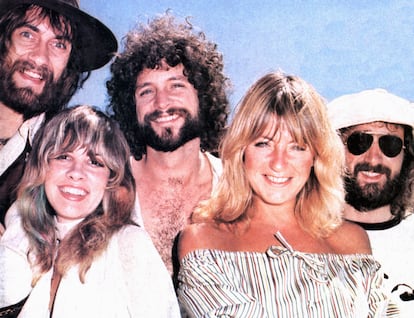The second youth of Lindsey Buckingham, Fleetwood Mac’s sonic architect
The singer achieved glory for the band, but never made it as a solo artist. The reissue of his forgotten albums comes at a time when the band is experiencing a new surge in popularity

The biggest hits were provided by Christine McVie and, to a lesser extent, Stevie Nicks, but Fleetwood Mac would never have become one of the most successful, admired and blessed bands on the planet between 1975 and 1987 without the decisive contributions of Lindsey Buckingham.
The male figure in this unparalleled trio of composers was bold, dramatic, and even excessive in his approach to songwriting. Go Your Own Way (1977) and Big Love (1987) — both bearing his signature — are still played on the radio, continuing to fuel music lovers’ nostalgia.
The band would never have made it without the contributions of a man who — beyond singing, composing and developing a very peculiar guitar technique — became a sound architect and instigator of tips and tricks in the recordings. And, without that juggling act, albums such as Rumours (1977), Tusk (1979) or Tango in the Night (1987) wouldn’t have reached historic heights. They’ve been preserved for posterity.
Buckingham is rarely vindicated. Hence, the recent recovery of his first three solo albums — out of production and difficult to locate, as unusual as this may seem — is an act of contrition on the part of an industry that always knew how to better understand and squeeze the talent of the two women in that unique quintet.
The 20th Century Lindsey box set — as its title suggests — brings together the three LPs that Buckingham had time to record on his own throughout the last century: Law and Order (1981), Go Insane (1984) and Out of the Cradle (1992). There’s also a fourth disc, which includes a few tasty rarities of the period: unreleased tracks, obscure singles, tunes commissioned for films and three alternative versions of Buckingham’s most successful songs (which had limited success in their heyday).
This four-part box set coincides with two other unexpected releases: the (partially) unreleased Fleetwood Mac concert Mirage Tour ’82 and the complete reworking of the album Buckingham Nicks (1973). This is by two artists with a big indie pedigree — Andrew Bird and Madison Cunningham — and bears the title Cunningham Bird (2024).
There’s no way around it: we must agree that Lindsey Adams Buckingham — a 75-year-old Californian — is experiencing a second youth, while his former group is also being vindicated by the new generations.

It makes sense that Stevie Nicks — magnetic and enigmatic like few others — also ended up emerging as a solo artist. Surrounded by the aura of an elusive enchantress, the Arizona native boasts several hits that have made her a legend: Rhiannon (1976), Sara (1979), Gypsy (1982), and Dreams (1977). In 2021, Rolling Stone magazine ranked Dreams as the ninth-best song of all time.
Her debut solo album, Bella Donna (1981), was so exceptional that it raised questions about her future in Fleetwood Mac — an uncertainty further fueled by the success of her follow-up, The Wild Heart (1983), and her unfortunate treatment with the anti-anxiety medication Klonopin, which only deepened her reliance on cocaine, a habit she was trying to overcome.
Christine McVie, more grounded and reserved, never felt the same need to step outside the band. Her only attempt in that direction— a self-titled album released in 1984— had a relatively modest impact. However, her contribution to the band that Mick Fleetwood and John McVie formed in 1967 is vast: Don’t Stop (1977), Say You Love Me (1975), Little Lies (1987), Over My Head (1975), Everywhere (1987), Over & Over (1979), You Make Loving Fun (1977)…
In 1998, McVie decided not to continue with Fleetwood Mac. This was because she had developed a fear of flying. She passed away in November 2022, at the age of 79, after spending three decades “dedicated mainly to gardening.”
In contrast, Buckingham was always ambitious to go solo, but the public systematically denied him the individual recognition he longed for. Returning to his three solo works from the 20th century — which many listeners will have buried in their memory — is a tasty and enjoyable exercise, as well as enlightening. Some cuts are extremely good and would surely have become resounding hits under Fleetwood Mac’s umbrella. So, the resentment that Lindsey developed towards his bandmates makes some sense. And even more so in the case of Nicks, an ex-partner with whom he’s experienced notorious episodes of both civilized cohabitation and acute animosity.

It’s true that the off-kilter Go Insane (1984) — the second of those solo works — lives up to its title. It represents an exercise in excess that’s both thunderous and gaudy, even though it has its funny moments (if you want to hear something sexy, put on Slow Dancing). On the other hand, the repertoire of Law and Order (1981) anticipated what Buckingham would bring to the band just one year later for the album Mirage (1982): a lesson in effective and elaborate pop — exemplified by his song Trouble — and an outdated fondness for the primitive pop of the 1950s, which Fleetwood Mac immortalized with Oh Diane (1982). But Buckingham had already done all of this with the extraordinary — and forgotten — Love From Here, Love From There (1981).
Buckingham’s album Out of the Cradle (1992) was a significant work, from the first word to the last. Its title can only refer to his disassociation from the band. The album was a burst of pride that brought together songs such as Wrong, Soul Drifter, and Countdown, some of his most memorable works. And all of them, once again, went unheard.
Buckingham thus stands as a colossal paradox. His beautiful album with Nicks, from 1973, is a folksy delicacy that nobody listened to. It has never been reissued (it can’t even be enjoyed on music streaming platforms). Yet, it served both of them: it led them to signing with a band that was in a slump and was about to be fired by Warner. Through Fleetwood Mac, they made history. That’s why the cover album Cunningham Bird — a complete recreation of his songwriting — is a wonderful act of justice.
We know that the sparkles, echoes of second voices, special effects and other studio tricks that popularized Fleetwood Mac were all his doing. Sadly, when Lindsey Buckingham released his solo work, those same innovations went largely ignored. But, as they say, that’s life.
Sign up for our weekly newsletter to get more English-language news coverage from EL PAÍS USA Edition
Tu suscripción se está usando en otro dispositivo
¿Quieres añadir otro usuario a tu suscripción?
Si continúas leyendo en este dispositivo, no se podrá leer en el otro.
FlechaTu suscripción se está usando en otro dispositivo y solo puedes acceder a EL PAÍS desde un dispositivo a la vez.
Si quieres compartir tu cuenta, cambia tu suscripción a la modalidad Premium, así podrás añadir otro usuario. Cada uno accederá con su propia cuenta de email, lo que os permitirá personalizar vuestra experiencia en EL PAÍS.
¿Tienes una suscripción de empresa? Accede aquí para contratar más cuentas.
En el caso de no saber quién está usando tu cuenta, te recomendamos cambiar tu contraseña aquí.
Si decides continuar compartiendo tu cuenta, este mensaje se mostrará en tu dispositivo y en el de la otra persona que está usando tu cuenta de forma indefinida, afectando a tu experiencia de lectura. Puedes consultar aquí los términos y condiciones de la suscripción digital.
More information
Archived In
Últimas noticias
NASA discovers Titan doesn’t have an ocean, but a ‘slushy ice layer’ that increases possibility of life
Innocence lost in the forest of the child soldiers: ‘Each leader of the armed group had his girls’
‘Fallout’ or how the world’s largest company turned an anti-capitalist apocalyptic Western into a phenomenon
From inflation to defending migrants: Eileen Higgins and Zohran Mamdani inaugurate the new Democratic resistance against Trump
Most viewed
- ‘El Limones’ and the growing union disguise of Mexican organized crime
- Christian Louboutin: ‘Young people don’t want to be like their parents. And if their parents wear sneakers, they’re going to look for something else’
- The low-cost creative revolution: How technology is making art accessible to everyone
- ‘We are dying’: Cuba sinks into a health crisis amid medicine shortages and misdiagnosis
- Liset Menéndez de la Prida, neuroscientist: ‘It’s not normal to constantly seek pleasure; it’s important to be bored, to be calm’











































